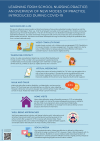New Modes of Practice: A Framework Analysis of School Nurses' Accounts of Working With Children and Young People During COVID-19
- PMID: 39352004
- PMCID: PMC11967332
- DOI: 10.1111/jan.16490
New Modes of Practice: A Framework Analysis of School Nurses' Accounts of Working With Children and Young People During COVID-19
Abstract
Aims: To identify new and accelerated modes of practice used by school nurses during the COVID pandemic. To create a quick reference infographic bringing together experiential evidence on the range and considerations regarding different modes of practice for use by the school nursing community of practice.
Design: A descriptive qualitative secondary data analysis of open-ended questions in a survey, and focus groups with school nurses. The pragmatic aim was to focus on changes in school nurse modes of practice to ensure continued engagement with children and young people, and school nurses' experience of the benefits and challenges of these modes of practice.
Methods: Data were collected from 98 school nurse participants across a United Kingdom-wide survey (n78) in April to May 2022, and focus groups (n20) in June to July 2022, within the School Nursing in the Time of COVID project. Data from the seven open-ended questions in the survey and four questions from the focus group were analysed using the framework approach.
Results: Modes of practice fell into two categories: individual assessment and support (video-calling platforms, telephone contact, virtual messaging, walk-and-talks and home visits) and group support (wellbeing approaches, social media). Considerations for these modes rooted in school nurses' experience are described. Interpretations were used to create the summarising evidence-based infographic as a quick reference resource for school nurses.
Conclusion: There was no 'one size fits all' approach. The modes used by school nurses were adopted or developed out of necessity or resource availability and in response to the specific needs of individuals or groups. The developed infographic provides a quick reference guide to deliver the expressed need for knowledge exchange within the school nursing community by participants in the original studies and can be used to inform current school nurse practice.
Implications for the profession and/or patient care: The developed evidence-based infographic has stand-alone value. It has the potential to raise awareness of the range of different strategies that can be used to facilitate and/or enhance engagement with children and young people, equip school nurses with knowledge to foster innovative and responsive practice and aid critical reflection in a complex post-pandemic landscape. The infographic is a unique resource and is a first step in knowledge exchange based on experiential learning. The resource will be used as the foundation for future work to develop a co-created training resource for school nurse students (undertaking the Specialist Community Public Health Nurses course) and/or continuing professional development resource for established school nurses.
Reporting method: This study has been conducted and reported in accordance with COREQ guidelines for qualitative research.
Patient or public contribution: A consultation group was closely involved with the planning, conduct and analysis of the original studies. This group consisted of representatives from professional organisations SAPHNA (School and Public Health Nurses Association) and the CPHVA (Community Practitioners' and Health Visitors' Association), a school nurse and a member of the public. SAPHNA have continued in their consultative role for this study and has provided content and usability feedback regarding the infographic. Early findings have been presented to the SN community of practice, and feedback invited, through presentation separately at the CPHVA and SAPHNA annual conference.
© 2024 The Author(s). Journal of Advanced Nursing published by John Wiley & Sons Ltd.
Conflict of interest statement
The authors declare no conflicts of interest.
Figures
References
-
- Anderson, L. N. , Yoshida‐Montezuma Y., Dewart N., et al. 2023. “Obesity and Weight Change During the COVID‐19 Pandemic in Children and Adults: A Systematic Review and Meta‐Analysis.” Obesity Reviews 24, no. 5: e13550. - PubMed
-
- Bekaert, S. , Sammut D., Appleton J., Taylor J., Harrold T., and Cook G.. 2023. “Learning From School Nursing Practices and New Ways of Working During the COVID‐19 Pandemic: A Qualitative Study.” British Journal of Child Health 4, no. 2: 71–77.
MeSH terms
Grants and funding
LinkOut - more resources
Full Text Sources
Medical
Miscellaneous


